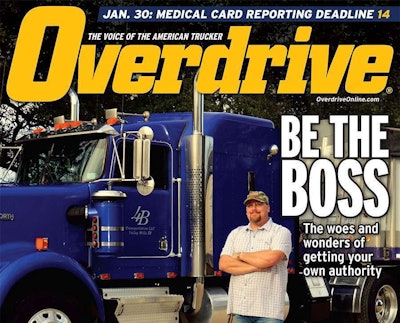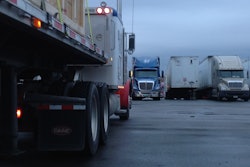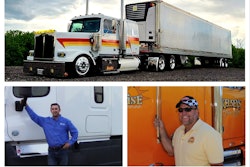 Overdrive‘s January cover story charted the particulars of gaining operating authority. The New Entrant test FMCSA is crafting would put yet another step in that process. Find Part 1 of the story via this link.
Overdrive‘s January cover story charted the particulars of gaining operating authority. The New Entrant test FMCSA is crafting would put yet another step in that process. Find Part 1 of the story via this link.The first of three planned federal listening sessions on the subject of New Entrant testing took place in Nashville, Tenn., January 13 on the occasion of the American Bus Association’s Marketplace conference. A New Entrant testing requirement for motor carriers, brokers and freight forwarders was mandated by the MAP-21 highway bill passed in Congress in 2012. Once established, the testing would constitute yet another step in the process for owner-operators applying for their carrier operating authority — and could potentially apply to existing businesses in certain circumstances, depending on the ultimate scope of the Federal Motor Carrier Safety Administration’s rulemaking.
Whether such rulemaking should necessarily include training in addition to testing requirements was central to much of the discussion. Among representatives from the trucking industry offering perspective was Hunter Owen of the National Association of Small Trucking Companies, who urged the agency to keep the rulemaking focused with testing on knowledge that is required by federal regulations and to look to the private sector to help in preparing New Entrants for both the exam and subsequent operation of the business.

NASTC holds monthly New Entrant training seminars at its Hendersonville, Tenn., headquarters, Owen said. The seminars are geared toward preparing for the New Entrant audit as well as, more broadly, strategies toward profitability. The latter ought to remain outside the appropriate regulatory scope, Owen and others said. All the same, Owen added, the federal test should be “much more than a teach-to-the-test exercise” and focus on the knowledge of those responsible for safety within new transportation entities. “Company principals are those who need to be tested,” he said.
A great deal of discussion as part of the session centered on that question — who exactly needs to be tested in any given company. Nancy O’Liddy of the Transportation Intermediaries Association pointed to her association’s individual broker certification programs, which include regulatory and business curricula, as a model suggestive of the need for a broader reach into new-entrant businesses with the test, at least on the brokerage side of things.
One commenter tuned in to the online broadcast of the session went so far as to question whether owner-operators leasing their trucks and businesses under another carrier’s authority ought to be required to test in to the industry.
Owen, however, urged regulators to stay focused with the testing. He cited the nature of most new businesses applying for motor carrier authority as very small operations, saying the test has to “be of the principal of the company, the person that’s getting the authority. I don’t see how you could do it another way.”
Allen England of the Tennessee Highway Patrol wondered whether state enforcement authorities could have a role in administering the test, given that those authorities are already processing audits of New Entrants within the first 18 months of the carrier’s business.
Owen cautioned against such involvement, given the delay that could result for the New Entrant getting up and running in business: “I don’t see it feasible to make somebody wait a year before they get their authority – I don’t see that as a viable solution.”
FMCSA Associate Administrator for Enforcement Bill Quade said at present the agency had in mind only a test for New Entrant carriers (brokers and freight forwarders could expect testing to apply to all existing entities, as directed by MAP-21), not an ongoing certification for existing businesses. Yet, as suggested by some commenters, the agency could consider triggering events, whether audits or data-based metrics showing patterns of unsafe activity, that would require retesting or recertification.
The FMCSA will conduct two more listening sessions in pursuit of this rulemaking in the coming months – March 28 at the Mid-America Trucking Show in Louisville, Ky., and April 7 at the meeting of the Commercial Vehicle Safety Alliance in Los Angeles.
|
VOICES ON THE NEW ENTRANT TEST Voices from readers to date on the notion of a New Entrant test have been largely supportive to one degree or another. “I see no problem with it,” said longtime independent owner-operator Melvin Davis Jr., based in Michigan. “If they want to be in this business then they need to know what they’re doing and what the rules are.” Texas-based Cody Blankenship, also featured in Overdrive‘s recent series on operating under your own authority, concurred that “time is now to bring some knowledge and professionalism back to trucking…. Being an owner-operator or a fleet owner should be a coveted thing.” Not all were sunny about the process of crafting the rule, however. Here’s reader Todd Ramey on the listening sessions: “Do you think they will even consider what a seasoned driver tells them? Their track record isn’t all that good.” Ramey offered the listening sessions devoted to the hours of service rewrite, in which drivers issued a clarion call for greater flexibility, as an example. In advance of further listening sessions upcoming in March at MATS and in April at the Los Angeles CVSA meeting, drivers can submit formal commentary on the testing using docket number FMCSA-2001-11061 at regulations.gov. |
Other issues probed in commentary from those attending the Nashville session included:
**Continuing education: By potentially requiring a periodic recertification or retesting (many offered the period of every five years as appropriate), the New Entrant test could help ensure ongoing knowledge of safety regulations among motor carriers and industry participants. Requiring recertification periodically and tying it to the MCS-150 process (making it mandatory every three years), wrote David Gray of the North American Transportation Services Association via the session’s online webcast, might seem reasonable. For FMCSA, such a required recertification would improve timeliness of carrier updates to the MCS-150 form, improving CSA data quality to a certain extent. The CSA Safety Measurement System relies on data from carriers MCS-150 filings to compute its carrier rankings in the Unsafe Driving and Crash Indicator BASIC categories.
**Administration of the test: While most parties argued for in-person, proctored testing, representatives such as NASTC’s Owen stressed the need to explore options to keep costs to the affected new businesses reasonable, potentially with online tests including some level of chain of custody to ensure the correct person is taking the test.
**Potential allowance of third-party safety consultants to take the test on behalf of motor carriers: Rick Gobbell, an independent safety consultant himself also working with NASTC, offered the notion that most carriers utilizing consultants tended to do so only “when they have a problem.” As did most other commenters, Gobbell favored direct engagement with the test by New Entrants, though Richard Wilson of TCRG Consulting, via the webcast, offered a recommendation that a provision for the assistance of safety consultants could potentially be utilized, with a follow-up test verifying the carrier’s knowledge during the New Entrant monitoring and auditing process.
**Registration process: Questions remained as to where exactly the test should come in the authority application process, whether after getting DOT and MC numbers or at some point later, prior to the New Entrant audit.
**Test specialization: Quade repeatedly drew the analogy between what he saw as a potential reality for the New Entrant test and the existing CDL program with its associated endorsements requiring testing beyond the basics. Legal divisions will necessitate at least three tests, Quade noted – for brokers/freight-forwarders, household goods carriers and other carriers – but recommendations to break up the “other carriers” into passenger-, freight- and hazmat-specific tests, among other categories, were issued by more than one commenter.
**Test failures: Questions to be addressed remained. “The folks that fail the test really create a challenge for us,” Quade noted. “There comes a question: If you fail this test, when can you take another test? There’s an assumption we would charge a fee for this test, though I don’t think we have the statutory authority to do it. How often do we let them take the test? How much of the government’s oversight resources do we let them spend?”












